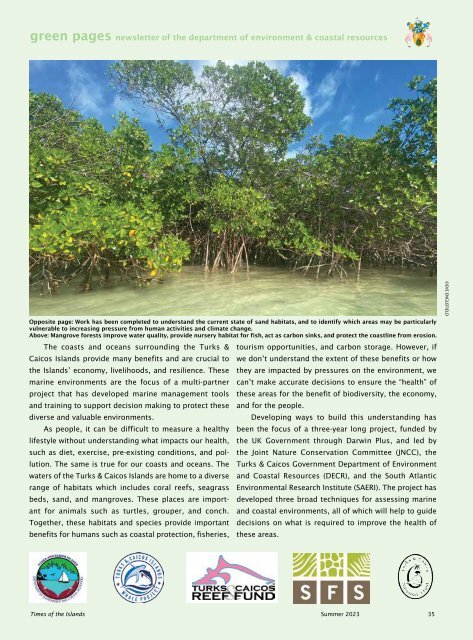Times of the Islands Summer 2023
Presents the "soul of the Turks & Caicos Islands" with in-depth features about local people, culture, history, environment, real estate, businesses, resorts, restaurants and activities.
Presents the "soul of the Turks & Caicos Islands" with in-depth features about local people, culture, history, environment, real estate, businesses, resorts, restaurants and activities.
Create successful ePaper yourself
Turn your PDF publications into a flip-book with our unique Google optimized e-Paper software.
green pages newsletter <strong>of</strong> <strong>the</strong> department <strong>of</strong> environment & coastal resources<br />
Opposite page: Work has been completed to understand <strong>the</strong> current state <strong>of</strong> sand habitats, and to identify which areas may be particularly<br />
vulnerable to increasing pressure from human activities and climate change.<br />
Above: Mangrove forests improve water quality, provide nursery habitat for fish, act as carbon sinks, and protect <strong>the</strong> coastline from erosion.<br />
The coasts and oceans surrounding <strong>the</strong> Turks &<br />
Caicos <strong>Islands</strong> provide many benefits and are crucial to<br />
<strong>the</strong> <strong>Islands</strong>’ economy, livelihoods, and resilience. These<br />
marine environments are <strong>the</strong> focus <strong>of</strong> a multi-partner<br />
project that has developed marine management tools<br />
and training to support decision making to protect <strong>the</strong>se<br />
diverse and valuable environments.<br />
As people, it can be difficult to measure a healthy<br />
lifestyle without understanding what impacts our health,<br />
such as diet, exercise, pre-existing conditions, and pollution.<br />
The same is true for our coasts and oceans. The<br />
waters <strong>of</strong> <strong>the</strong> Turks & Caicos <strong>Islands</strong> are home to a diverse<br />
range <strong>of</strong> habitats which includes coral reefs, seagrass<br />
beds, sand, and mangroves. These places are important<br />
for animals such as turtles, grouper, and conch.<br />
Toge<strong>the</strong>r, <strong>the</strong>se habitats and species provide important<br />
benefits for humans such as coastal protection, fisheries,<br />
tourism opportunities, and carbon storage. However, if<br />
we don’t understand <strong>the</strong> extent <strong>of</strong> <strong>the</strong>se benefits or how<br />
<strong>the</strong>y are impacted by pressures on <strong>the</strong> environment, we<br />
can’t make accurate decisions to ensure <strong>the</strong> “health” <strong>of</strong><br />
<strong>the</strong>se areas for <strong>the</strong> benefit <strong>of</strong> biodiversity, <strong>the</strong> economy,<br />
and for <strong>the</strong> people.<br />
Developing ways to build this understanding has<br />
been <strong>the</strong> focus <strong>of</strong> a three-year long project, funded by<br />
<strong>the</strong> UK Government through Darwin Plus, and led by<br />
<strong>the</strong> Joint Nature Conservation Committee (JNCC), <strong>the</strong><br />
Turks & Caicos Government Department <strong>of</strong> Environment<br />
and Coastal Resources (DECR), and <strong>the</strong> South Atlantic<br />
Environmental Research Institute (SAERI). The project has<br />
developed three broad techniques for assessing marine<br />
and coastal environments, all <strong>of</strong> which will help to guide<br />
decisions on what is required to improve <strong>the</strong> health <strong>of</strong><br />
<strong>the</strong>se areas.<br />
©EVE ENGLEFIELD<br />
<strong>Times</strong> <strong>of</strong> <strong>the</strong> <strong>Islands</strong> <strong>Summer</strong> <strong>2023</strong> 35
















